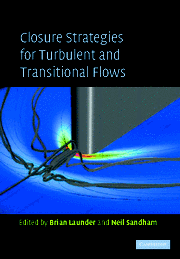16 - DNS of Bypass Transition
Published online by Cambridge University Press: 06 July 2010
Summary
Although direct numerical simulation (DNS) databases have had an impact on the development of models for fully turbulent flows, computer simulations of bypass transition have only recently become available and their impact on modeling has been very much less. The conditions of bypass transition make direct simulation a natural resource; there is little doubt that its use in this field will continue to grow. Direct simulation is restricted to low Reynolds number and to simple geometries because of its great demand on computer speed and memory. These restrictions may not be a debilitating handicap for many transition applications: by their very nature, transitional phenomena occur at Reynolds numbers that are low compared to fully turbulent flow. Since focus is on the vicinity of the transition line, geometrical complexity is not a controlling factor.
Simulation databases increasingly will be used to develop and test models, and to understand phenomena; for these purposes they provide highly resolved data, with well defined inlet conditions. Computational data are often of higher quality than analogous laboratory experiments. The geometry and the nature of the external disturbances that provoke transition are prescribed analytically and can be reproduced exactly in Reynolds averaged simulations. Free-stream turbulence intensity and integral scale can be specified at the inlet. A wealth of instantaneous flow fields and ensemble averaged data are available for basic and applied inquiries. Instantaneous flow fields provide views of the development of perturbations in the transitional zone and elucidate the initial stages of coupling between free-stream eddies and boundary layer disturbances. These are the phenomological underpinnings of the averaged data. The figures contained herein provide a sampling of the phenomological and statical resources of DNS.
Certain simulations have already begun to fill a niche left open by laboratory experiments. The periodic, wake induced transition discussed in §3 is a case in point. In some applications the simulation codes themselves might be a tool to use for predictive purposes. For instance, bypass transition in low pressure turbines is critical to some designs. The need for accurate prediction might warrant direct simulation.
The role of bypass transition
Under a quiet free-stream, a laminar boundary layer becomes linearly unstable beyond a critical Reynolds number at which Tollmein–Schlichting waves start to grow. The instability is via a subtle mechanism whereby viscosity destabilizes the waves (Drazin and Reid 1981). That subtle mechanism produces very slow growth.
- Type
- Chapter
- Information
- Closure Strategies for Turbulent and Transitional Flows , pp. 449 - 463Publisher: Cambridge University PressPrint publication year: 2002
- 8
- Cited by



